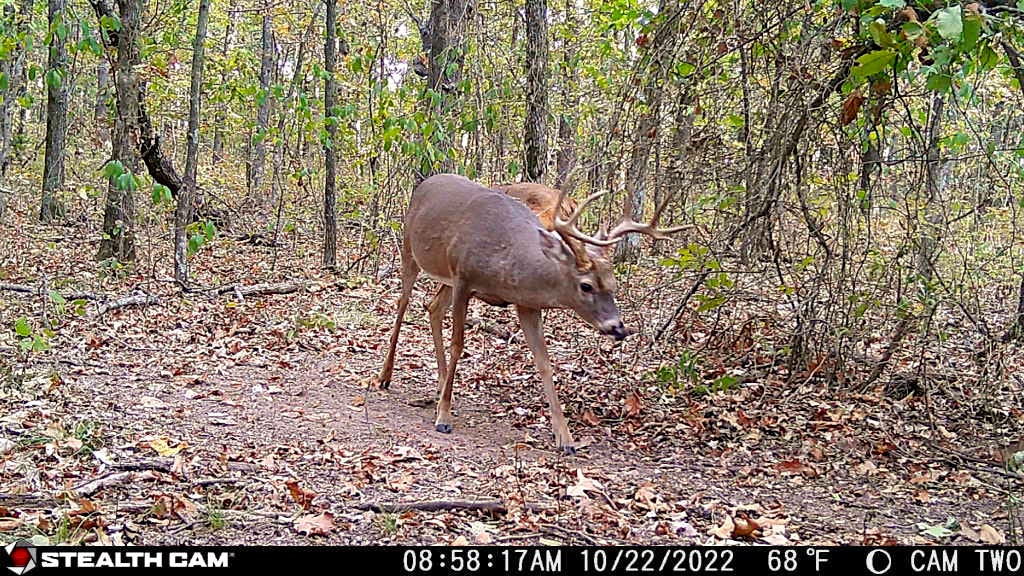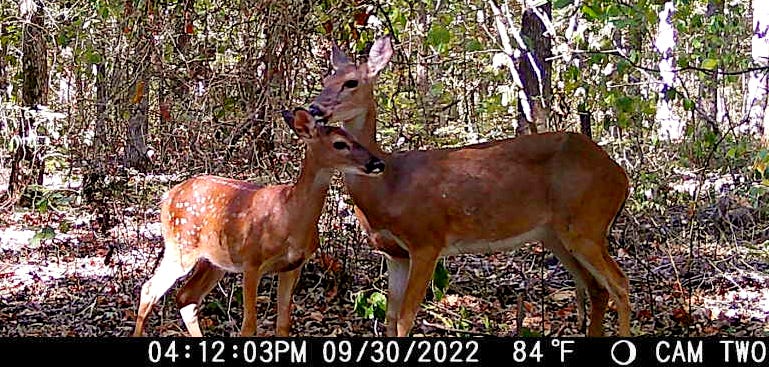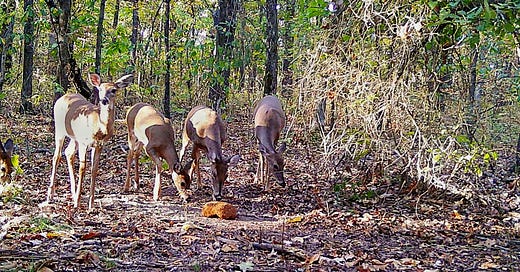Creek Bends: Why we are on doe patrol
The Stealth Cam reveals why 'Hunters in The Know, Take a Doe' is more than a slogan

I could easily imagine the opening morning of muzzleloader season on the ridge over Snake Creek Saturday.
With the 25- to 30-mph southerly gusts the woods sigh in autumn. Granted, 60 degrees on the way to 80 in the afternoon, is not exactly a crisp fall morning, but it beats 75 on the way to 90.
The rush through leaves sounds more like ocean surf breaking through or a low jet airliner on approach, but I like the idea of a sigh. It’s like a giant collective exhale of trees ready to shed the dust and detritus of a long hot summer and the weight of withering leaves.
“Ahhhhh-OhhhhhAHHH, winter is near.”
I haven’t cut that one danged limb yet, though. Writing about the wind reminds me. That would have colored my morning.
One little point of a dead limb above the Muddy pop-up blind hangs just low enough to lightly touch the top. With consistent winds, it becomes like fingernails on a chalkboard.
Scritch-scritch, scritch, scritch-scritch-scritch-scritch-scrith, scritch-scritch.
All it will take is one little snip or snap. But I typically arrive in the dark and when I leave I usually have to run and pee, so I really haven’t figured out exactly where that branch is located. I just keep forgetting—until the next time the wind blows.
By 9 a.m. dawn’s chill and the anticipation of sunrise whitetail activity would have been a memory. By then I’m usually doing the math on staying until 10 a.m., doing the physical math on whether I can hold out to 10:30 or 11 a.m., and the real math of mentally ticking off deer movement times recorded on the Stealth Cams and trying to make sense of moon cycles.
Heady stuff, those thoughts around deer-stand deadlines.

Minutes before 9, I’m sure the win gusted, the sounds of the woodpeckers and squirrels, cardinals and crows faded, and I’d have seen the silent ghostly approach of two dark brown shapes, maybe with a white flash or glint of sunlight off an antler, as two young bucks approached.
Imagined, and would have, because I wasn’t there. And neither would those bucks have been with that strong south wind. The ridge, I’ve learned, is best hunted with a northerly breeze of 6 mph or better.
But I know they stopped by because of the Stealth Cam photo taken at 8:57 a.m. Saturday and sent to my iPhone at 9 a.m.
Thing is, I wouldn’t have shot either one of them anyway. In fact I hope they both make it to next year and beyond.
We have very little control over that. My Snake Creek landowners and his neighbor together control only about 100 acres, while deer typically inhabit an area of 1,000 or a bit more.

A lot of hunters would be happy with either of those bucks, especially taken with a bow. But we’re not about hunting bucks this year, or any, really. The landowner likes to see deer and likes to see beautiful bucks, but at the same time understands conservation. He also understands that if that one particular giant old buck in the sunset of his life comes along, well, Kelly might have to draw his bow, but that will be a rare specimen.
This year it’s not the photo of the bucks on muzzleloader opening day that inspired our Doe Patrol mode. Photos at the end of September and into mid-October of skin-and-bones does with fawns still bearing spots showed why we need to focus on does.
I texted one of the clearest photos to Dallas Barber, big game biologist for the Oklahoma Department of Wildlife Conservation.
“Late-born fawns = skewed buck:doe ratios,” he replied. “She probably was bred in December or January.

What biologists emphasize about buck:doe ratios is the ability of bucks to cover all the does in estrous, within their range, during the rut, which is about to begin. Does that are not bred will enter estrous again, and again, and bucks will continue to chase and act like they’re in the rut well into January. It goes as long as that scent is in the air, so to speak.
It’s best to get it all completed in the November time frame, get everyone back on the task of surviving the winter in a healthy fashion and have most fawns hit the ground at the same time in the spring.
The ideal “buck:doe” ratio that managers shoot for is 1:1.
That way you don’t end up with things like our doe that was nursing twins during a drought in triple-digit heat in August. She’s one tough old gal. Her visible ribs and prominent hips show this past summer’s toll.
I dropped a mineral block and some rice bran at a busy spot on the ridge on Oct. 1, and started counting does and bucks after the first two spotted fawns showed on camera the last week of September.
The two larger bucks and one other healthy eight-point are the only truly mature bucks to stop by.
We have plenty of does. At least two have late-born fawns and one has a pair of late-born twins. Looks like we have another three does that are loners, maybe four or five? It’s hard to tell one doe from another. Another couple does have older-looking youngsters, including one true, healthy, little button-buck. After just three weeks I wouldn’t consider it a definitive count, and with the hunting seasons coming up it will change, but we have plenty of early evidence that eliminating several does likely will help the local population. It definitely won’t hurt.




